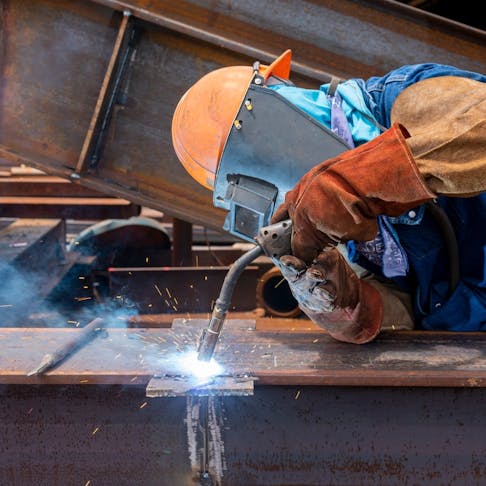Advanced Welding WPS: Tailoring Requirements for Facility Jobs
Advanced Welding WPS: Tailoring Requirements for Facility Jobs
Blog Article
Opening the Power of Welding WPS: Approaches for Efficiency and Safety And Security in Construction
In the realm of construction, Welding Treatment Specifications (WPS) stand as the backbone of welding procedures, determining the required actions for accomplishing both performance and safety in the fabrication procedure. Understanding the details of WPS is vital to harnessing its complete possibility, yet numerous organizations have a hard time to open the real power that exists within these papers (welding WPS). By delving right into the strategies that maximize welding WPS, a globe of enhanced performance and heightened safety and security awaits those happy to discover the nuances of this vital facet of construction

Importance of Welding WPS
The relevance of Welding Procedure Requirements (WPS) in the fabrication market can not be overstated. WPS offer as a vital roadmap that describes the essential steps to make certain welds are done regularly and properly. By specifying important criteria such as welding procedures, materials, joint designs, preheat temperature levels, interpass temperature levels, filler metals, and post-weld warmth treatment requirements, WPS provide a standard approach to welding that boosts efficiency, quality, and safety in manufacture procedures.
Adherence to WPS helps in accomplishing uniformity in weld top quality, minimizing the probability of defects or structural failures. This standardization additionally facilitates compliance with sector regulations and codes, making sure that made structures meet the called for safety and security criteria. Furthermore, WPS documents makes it possible for welders to replicate effective welding procedures, resulting in consistent outcomes across different tasks.
Fundamentally, the thorough growth and stringent adherence to Welding Procedure Requirements are vital for promoting the honesty of bonded structures, protecting against prospective threats, and maintaining the track record of construction business for delivering top notch products and services.
Secret Aspects of Welding WPS

Enhancing Efficiency With WPS
When optimizing welding operations, leveraging the key aspects described in Welding Procedure Requirements (WPS) ends up being vital for optimizing and streamlining processes efficiency. One method to improve efficiency with WPS is by meticulously choosing the appropriate welding specifications.
Furthermore, correct training and accreditation of welders in understanding and applying WPS can additionally improve efficiency. Making sure that all team participants are well-versed in interpreting and carrying out the WPS accurately can rework and decrease errors, conserving both time and sources. Consistently assessing and upgrading the WPS to incorporate any type of lessons learned Recommended Site or technical improvements can likewise add to performance improvements in welding operations. By welcoming the guidelines stated in the WPS and continually seeking methods to maximize processes, makers can attain higher performance degrees and superior end results.
Ensuring Safety in Fabrication

Ensuring safety in manufacture includes a multifaceted method that incorporates different elements of the welding procedure. Welders need to be outfitted with ideal gear such as safety helmets, gloves, and protective clothing to mitigate risks associated with welding activities.
Furthermore, adherence to appropriate ventilation and fume removal systems is important in keeping a healthy workplace. Welding fumes include unsafe compounds that, if breathed in, can pose major health and wellness dangers. Implementing efficient air flow actions helps to lessen direct exposure to these dangerous fumes, advertising respiratory system health among employees.
Normal tools upkeep and evaluations are likewise necessary for making certain safety in construction. Damaged equipment can lead to mishaps and injuries, emphasizing the importance of prompt repairs and routine checks. By prioritizing precaution and cultivating a society of recognition, fabrication facilities can create a effective and protected workplace for their employees.
Implementing WPS Best Practices
To boost functional efficiency and guarantee high quality results in construction processes, integrating Welding Treatment Requirements (WPS) best techniques is extremely important - welding WPS. Implementing WPS ideal techniques entails careful preparation, adherence to market requirements, and constant monitoring to guarantee ideal outcomes. To start with, picking the proper welding process, filler material, and preheat temperature defined in the WPS is critical for attaining the preferred weld high quality. Secondly, ensuring that certified welders with the required certifications accomplish the welding procedures according to the WPS guidelines is essential for uniformity and dependability. On a regular basis upgrading and examining WPS files to investigate this site reflect any kind of process renovations or adjustments in materials is likewise a vital finest practice to keep accuracy and relevance. In addition, offering comprehensive training to welding employees on WPS demands and ideal practices fosters a society of safety and security and high quality within the fabrication setting. By vigilantly applying WPS finest practices, producers can streamline their procedures, minimize mistakes, and deliver remarkable products to meet client assumptions.
Verdict
In conclusion, welding WPS plays an important function in making sure effectiveness and security in fabrication processes. By adhering to these approaches, businesses can unlock the complete potential of anonymous welding WPS in their manufacture procedures.
In the realm of manufacture, Welding Treatment Specifications (WPS) stand as the foundation of welding procedures, dictating the essential actions for achieving both efficiency and security in the manufacture process. By defining important specifications such as welding procedures, materials, joint styles, preheat temperatures, interpass temperatures, filler metals, and post-weld warm treatment requirements, WPS supply a standard approach to welding that enhances performance, quality, and safety in manufacture processes.

When enhancing welding procedures, leveraging the crucial aspects outlined in Welding Treatment Requirements (WPS) ends up being important for making best use of and improving procedures productivity. (welding WPS)
Report this page